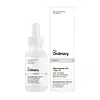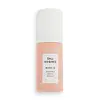What's inside
What's inside
 Key Ingredients
Key Ingredients

 Benefits
Benefits

 Concerns
Concerns

 Ingredients Side-by-side
Ingredients Side-by-side

Water
Skin ConditioningAscorbyl Glucoside
AntioxidantC15-19 Alkane
SolventNiacinamide
SmoothingPropanediol
SolventCaprylic/Capric Triglyceride
MaskingSodium Hydroxide
BufferingTocopherol
AntioxidantGlycerin
HumectantGlyceryl Stearate
EmollientBenzyl Alcohol
PerfumingCandelilla/Jojoba/Rice Bran Polyglyceryl-3 Esters
EmulsifyingFerulic Acid
AntimicrobialSodium Gluconate
Skin ConditioningCetearyl Alcohol
EmollientSodium Stearoyl Lactylate
EmulsifyingRicinus Communis Seed Oil
MaskingHydroxyethyl Acrylate/Sodium Acryloyldimethyl Taurate Copolymer
Emulsion StabilisingSodium Metabisulfite
AntioxidantSqualane
EmollientXanthan Gum
EmulsifyingEthylhexylglycerin
Skin ConditioningSodium Hyaluronate
HumectantParfum
MaskingPolysorbate 60
EmulsifyingHydrogenated Castor Oil
EmollientSorbitan Isostearate
EmulsifyingCoumarin
PerfumingLinalool
PerfumingGeraniol
PerfumingCitronellol
PerfumingEugenol
PerfumingWater, Ascorbyl Glucoside, C15-19 Alkane, Niacinamide, Propanediol, Caprylic/Capric Triglyceride, Sodium Hydroxide, Tocopherol, Glycerin, Glyceryl Stearate, Benzyl Alcohol, Candelilla/Jojoba/Rice Bran Polyglyceryl-3 Esters, Ferulic Acid, Sodium Gluconate, Cetearyl Alcohol, Sodium Stearoyl Lactylate, Ricinus Communis Seed Oil, Hydroxyethyl Acrylate/Sodium Acryloyldimethyl Taurate Copolymer, Sodium Metabisulfite, Squalane, Xanthan Gum, Ethylhexylglycerin, Sodium Hyaluronate, Parfum, Polysorbate 60, Hydrogenated Castor Oil, Sorbitan Isostearate, Coumarin, Linalool, Geraniol, Citronellol, Eugenol
 Reviews
Reviews

Ingredients Explained
These ingredients are found in both products.
Ingredients higher up in an ingredient list are typically present in a larger amount.
Niacinamide is a multitasking form of vitamin B3 that strengthens the skin barrier, reduces pores and dark spots, regulates oil, and improves signs of aging.
And the best part? It's gentle and well-tolerated by most skin types, including sensitive and reactive skin.
You might have heard of "niacin flush", or the reddening of skin that causes itchiness. Niacinamide has not been found to cause this.
In very rare cases, some individuals may not be able to tolerate niacinamide at all or experience an allergic reaction to it.
If you are experiencing flaking, irritation, and dryness with this ingredient, be sure to double check all your products as this ingredient can be found in all categories of skincare.
When incorporating niacinamide into your routine, look out for concentration amounts. Typically, 5% niacinamide provides benefits such as fading dark spots. However, if you have sensitive skin, it is better to begin with a smaller concentration.
When you apply niacinamide to your skin, your body converts it into nicotinamide adenine dinucleotide (NAD). NAD is an essential coenzyme that is already found in your cells as "fuel" and powers countless biological processes.
In your skin, NAD helps repair cell damage, produce new healthy cells, support collagen production, strengthen the skin barrier, and fight environmental stressors (like UV and pollution).
Our natural NAD levels start to decline with age, leading to slower skin repair, visible aging, and a weaker skin barrier. By providing your skin niacinamide, you're recharging your skin's NAD levels. This leads to stronger, healthier, and younger looking skin.
Another name for vitamin B3 is nicotinamide. This vitamin is water-soluble and our bodies don't store it. We obtain Vitamin B3 from either food or skincare. Meat, fish, wheat, yeast, and leafy greens contain vitamin B3.
The type of niacinamide used in skincare is synthetically created.
Learn more about NiacinamideWater. It's the most common cosmetic ingredient of all. You'll usually see it at the top of ingredient lists, meaning that it makes up the largest part of the product.
So why is it so popular? Water most often acts as a solvent - this means that it helps dissolve other ingredients into the formulation.
You'll also recognize water as that liquid we all need to stay alive. If you see this, drink a glass of water. Stay hydrated!
Learn more about WaterXanthan gum is used as a stabilizer and thickener within cosmetic products. It helps give products a sticky, thick feeling - preventing them from being too runny.
On the technical side of things, xanthan gum is a polysaccharide - a combination consisting of multiple sugar molecules bonded together.
Xanthan gum is a pretty common and great ingredient. It is a natural, non-toxic, non-irritating ingredient that is also commonly used in food products.
Learn more about Xanthan Gum